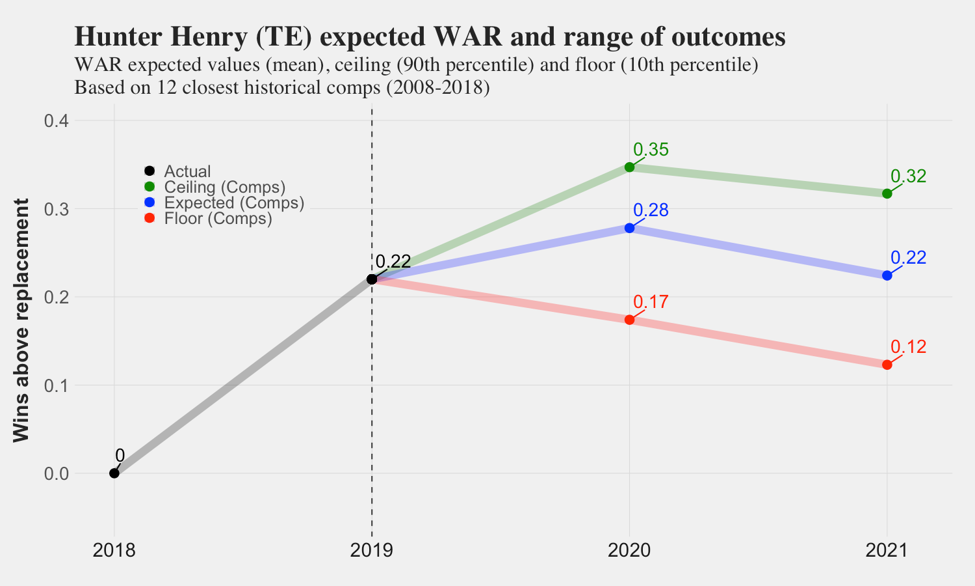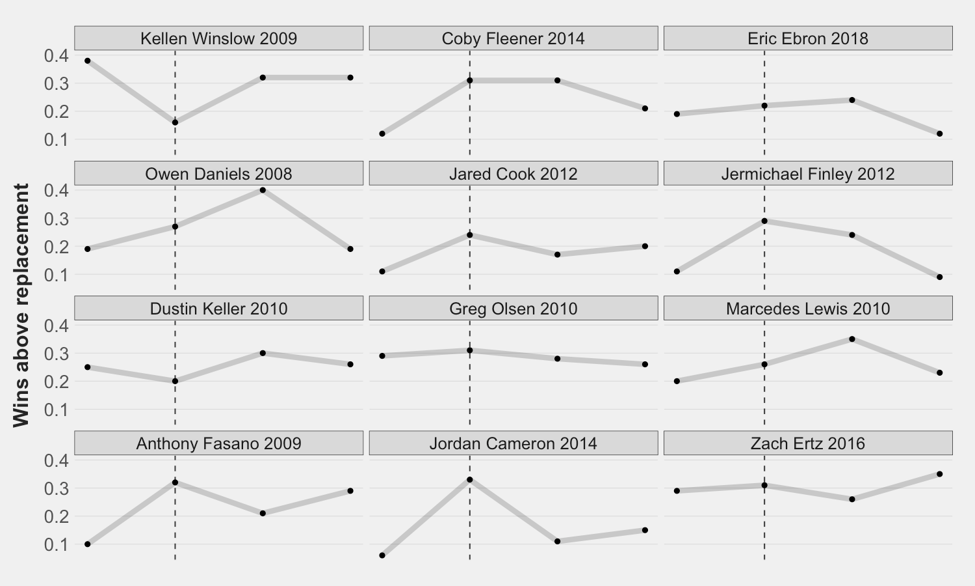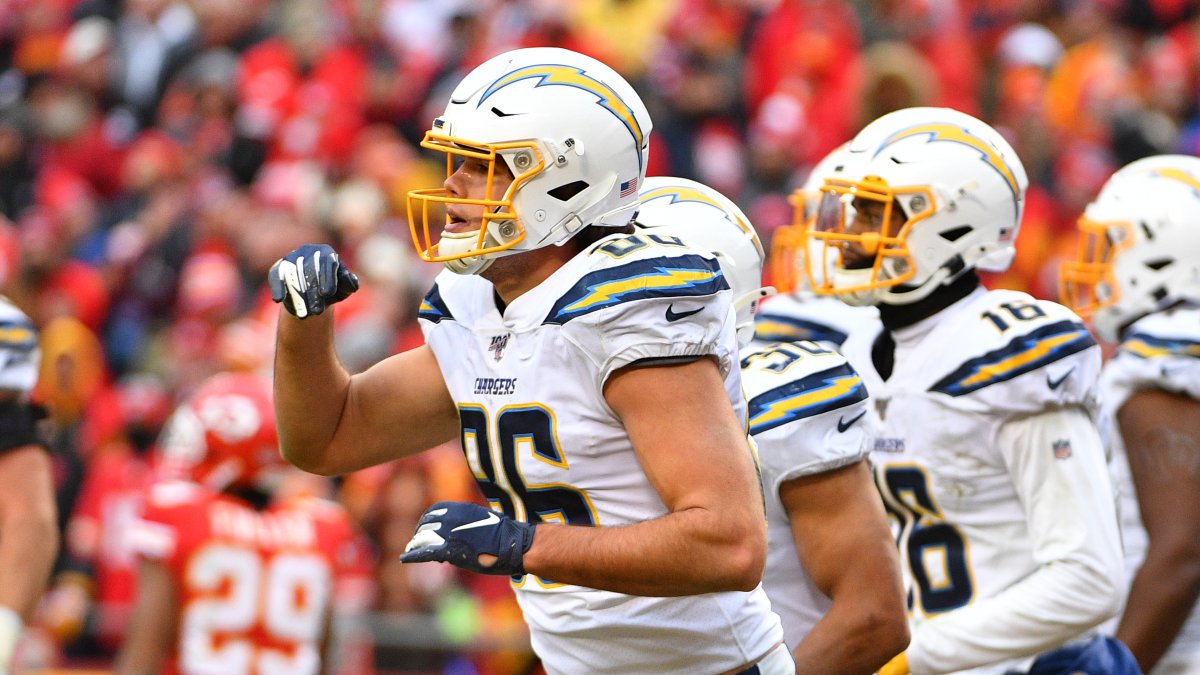With only two teams remaining to compete in the Super Bowl, the offseason is in full swing for the rest of the NFL and football pundits. We at PFF are also getting into the action with the launch of our 2020 Draft Guide and new Free Agency Rankings tool, which allows you to sort by position and team needs and includes contract projections from OverTheCap as well as historical grades and wins above replacement numbers for the past three seasons.
I am also doing a series of articles that will go through our top-50 ranked free agents (excluding QBs), using their past stats to match them with historical players. Once we have a sample of similar players, we can see how those similar players performed in subsequent seasons to get an idea of the current player’s range of outcomes.
This system is similar to FiveThirtyEight’s CARMELO player projections, only it is applied to football and uses PFF’s WAR metric as the proxy for player value.
In earlier research, I looked at historical WAR and salary cap figures to derive the approximate cost of a win. Adjustments to our WAR calculation and the ever-rising NFL salary cap has moved the current estimate for the price of a win for spending on unrestricted free agents at 34.2% of the cap, or $68.4 million based on an assumed 2020 cap of $200 million.
Buying wins in free agency is an expensive proposition, but the value of each incremental win for a playoff-caliber team cannot be understated. This year, teams are going to have tough decisions on how to spend that money. The first installment on wide receivers was published last week. In this article, we’re forecasting free agents at the tight end and running back positions.
Methodology
For each of the tight ends and running backs below, the closest comparable players were found by measuring the similarity between them based on several features — age (within one year), weight, WAR, previous-year WAR, targets per game, average depth of target (or rushing attempts per game for RBs), PFF route grades (PFF rushing grades), and WAR per snap.
The most similar players across these metrics are grouped together to calculate the expected WAR numbers for 2020 and 2021, with the weight of each comp reflecting the level of similarity. I didn’t use the same number of comps for all players, as it is more difficult to find a wide range of comparable seasons for older players.
The first plot displays past and future performance for the free agent based on the comp, the next shows the relevant WAR numbers for each of the comps and the final table gives the dollar-based value figures for 2018-2021, with assumed per-team salary caps of $200 million in 2020 and $215 million in 2021. I decided to restrict the forecasts to the next two years in order to maximize the number of comparable players we have in the dataset, reduce error for longer forecasts and reflect the fact that all but the top-tier free agent contracts in the NFL are glorified two-year deals that give teams the option to continue.
No. 15: Hunter Henry

Henry is our top-ranked tight end of potential 2020 free agents. Henry’s comparable players have a relatively narrow range of outcomes, with his ceiling roughly 0.1 WAR above what he generated in 2019, and his floor less than 0.1 WAR in the other direction. Not pictured in the forecast above is the 0.26 WAR Henry generated in 2017, before missing the 2018 season.
The issue with Henry will be his ability to stay healthy. Henry’s projected WAR numbers will probably come with a discount after missing the entire 2018 season with an ACL tear, and four games in 2019 with a tibia fracture in the same knee. Sports Injury Predictor sees a 51% chance Henry misses at least two quarters in 2020, and places him in the least durable category for player.

The range of outcomes for a productive, young tight end go from Zach Ertz to Jordan Cameron. Henry won’t even be 26 years old entering the 2020 season, leaving potential for years of prime production on his next contract.
| Outcome | 2018 | 2019 | 2020 | 2021 | Two-Year Per |
| Actual/Expected | $0.0 | $14.2 | $19.2 | $16.2 | $17.7 |
| Ceiling (90th) | N/A | N/A | $23.9 | $23.5 | $23.7 |
| Floor (10th) | N/A | N/A | $11.6 | $8.8 | $10.2 |
OverTheCap sees Henry taking a one-year, prove-it deal for around $9.5 million. That would likely be a win-win for his signing team and Henry if he hits the forecasted projections. If a team can convince Henry to take a longer deal at a reasonable number, there could be a lot of upside.
Exclusive content for premium subscribers

WANT TO KEEP READING?
Dominate Fantasy Football & Betting with AI-Powered Data & Tools Trusted By All 32 Teams
Already have a subscription? Log in



 © 2025 PFF - all rights reserved.
© 2025 PFF - all rights reserved.